

The wings of the butterfly. Heic1518 — Photo Release New Hubble image of the Twin Jet Nebula 26 August 2015 The shimmering colours visible in this NASA/ESA Hubble Space Telescope image show off the remarkable complexity of the Twin Jet Nebula.
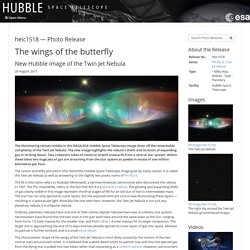
The new image highlights the nebula’s shells and its knots of expanding gas in striking detail. Two iridescent lobes of material stretch outwards from a central star system. The cosmic butterfly pictured in this NASA/ESA Hubble Space Telescope image goes by many names. The M in this name refers to Rudolph Minkowski, a German-American astronomer who discovered the nebula in 1947. Ordinary planetary nebulae have one star at their centre, bipolar nebulae have two, in a binary star system. Observing Space sur Twitter : "A near-infrared view of the iconic Pillars of Creation #hubble #nasa #esa. Hubble Goes High Def to Revisit the Iconic 'Pillars of Creation' (01/05/2015) - Release Images. 23 years old and still trucking: Hubble's best pics. Almost 23 years ago, the $2 billion (£1.3 billion) Hubble Space Telescope was launched into orbit on the Space Shuttle Discovery.
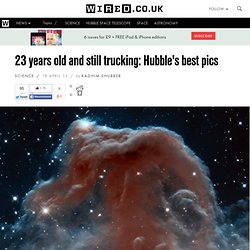
The launch, on 24 April 1990, marked the beginning of a new era of space photography. Hubble transformed the public's perception of astronomy with the incredible images (see gallery) of space it was able to beam back to Earth. But its contribution to scientific knowledge was equal, if not greater, than its worth as a public relations tool.
Hubble Goes to the eXtreme to Assemble Farthest-Ever View of the Universe. Hubble Goes to the eXtreme to Assemble Farthest-Ever View of the Universe Like photographers assembling a portfolio of best shots, astronomers have assembled a new, improved portrait of mankind's deepest-ever view of the universe.
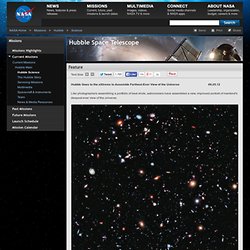
(Credit: NASA; ESA; G. Illingworth, D. Magee, and P. Oesch, University of California, Santa Cruz; R. Hubble’s Hidden Treasures Unveiled. Want to stay on top of all the space news?

Follow @universetoday on Twitter A quick check of Hubble’s gallery shows just 1,300 images; however more than raw 700,000 images reside in a vast archive with hundreds of potentially jaw-dropping astronomical scenes just waiting to be uncovered. That was the idea behind the European Space Agency’s international contest called Hubble’s Hidden Treasures. And now with the hard work of amateur astronomers and more than 3,000 submissions, some of Hubble’s incredible celestial treasures are revealed. “The response was impressive, with almost 3000 submissions,” the ESA said in a press release. Hubble's Hidden Treasures. Hubble's Hidden Treasures — Image Processing. Hubble's Hidden Treasures 2012. Since 1990, Hubble has made more than a million observations.

We feature many of these on spacetelescope.org, and the most stunning are in our Top 100 gallery and iPad app. But there are thousands of pictures in Hubble’s science archive that have only been seen by a few scientists. We call these images Hubble’s hidden treasures — stunning images of astronomical phenomena that have never been seen and enjoyed by the public.
Every week, we search the archive for hidden treasures, process the scientific data into attractive images and publish them as the Hubble Picture of the Week. Join the 2012 Hubble's Hidden Treasures Competition. Over two decades in orbit, the Hubble Space Telescope has made a huge number of observations.
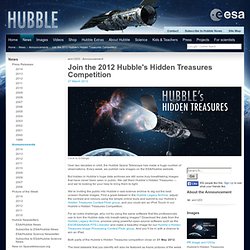
ESA/Hubble. Hubble NICMOS infrared image of M51. Les paysages variés de la nébuleuse de la Tarentule photographiés par Hubble. Beauté éblouissante de la nébuleuse de la Tarentule Le télescope spatial Hubble, qui fête ses 22 ans, publie une mosaïque d’images vertigineuses de l’une des plus impressionnantes matrices d’étoiles dans notre voisinage galactique, la nébuleuse de la Tarentule.
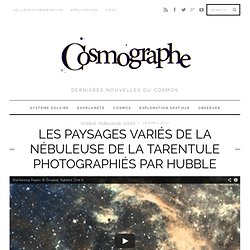
L’image est fascinante. Nous pénétrons dans un vaste paysage cosmique qui s’étend sur environ 650 années-lumière. Cela se passe à 170 000 années-lumière de nous, dans la galaxie naine du Grand Nuage de Magellan (LMC). Même si cette dernière présente des dimensions relativement modestes par rapport à la Voie Lactée (notre galaxie s’étend sur 100 000 années-lumière !) Dans les moindres plis et replis du nuage moléculaire se cache des centaines d’étoiles très jeunes. Outre les circonvolutions du gaz, ses envolées et déchirements qui composent la toile, notre regard est aussi attiré par les nombreuses grappes d’étoiles accrochées aux branches.
Hubble gomme les frontières entre l’art et la science. Hubble Legacy Archive. Hubble Space Telescope Images 2010 The Stars Like Dust - Jonn Serrie. Out of the ordinary...out of this world. Amazing Hubble Pictures. Photograph courtesy John Spencer (Lowell Observatory) and NASA In 1999, to commemorate the ninth anniversary since its launch, the Hubble Space Telescope took this dramatic snapshot of Jupiter’s moon Io and its shadow sweeping across the gas giant’s turbulent atmosphere.
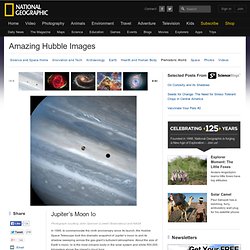
About the size of Earth’s moon, Io is the most volcanic body in the solar system and orbits 500,000 kilometers above the planet’s cloud tops. Rovio takes its popular game to the final frontier with Angry Birds Space, launching March 22, in partnership with National Geographic Books and NASA. Purchase the official companion book National Geographic Angry Birds Space. ESA/Hubble Flashbacks.